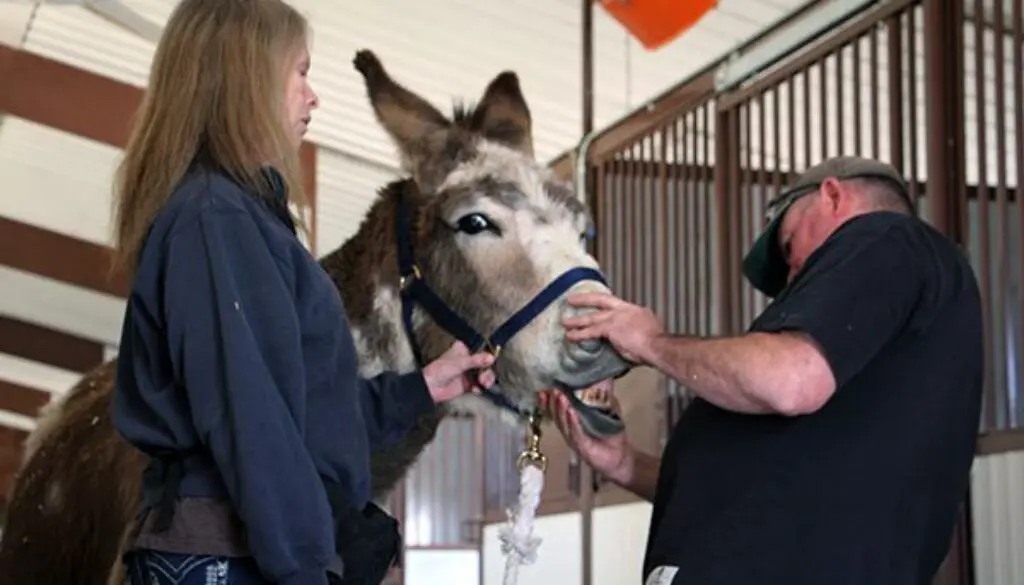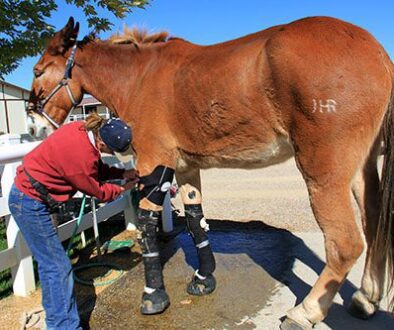Chasity’s Challenges: Chasity’s Health Check 3-31-20
Our veterinarian, Greg Farrand, came to do a health check on Chasity the day after she arrived. She obviously needs a lot of core strength work, but it will improve her health and keep her occupied while she is in quarantine. Simple core strength leading lessons will have a dramatic effect on her overall health and welfare both physically and mentally. Wrangler looks on with interest as the vet surveys her condition.

He thought because of her enlarged, fallen crested neck and all the fatty deposits over her body that she may have foundered. But her feet were in pretty good shape…no stress rings from founder.


She did have Borium shoes on the front feet (maybe previously used for parades on asphalt?). They were inordinately grown out and her hooves behind were also a bit long in the heels. She was definitely out of balance.


When we looked at her udder, we noticed that she had possibly been nursing before she came to us. She had what looked like milk dripping from extended teats and dried fluid caked on the insides of her legs.


She has cataracts starting in her eyes which made her a bit head shy…



…but, her teeth had just been floated and they were good.

Her posture is terrible with substantial Lordosis (sway back) even though she is only 13 years old! She exhibits the posture of a jennet after several foals. Her fallen, crested neck will be another challenge. However, she is a very sweet and cooperative girl! She is obviously the victim of some negligence… intentional or not.


When Chasity begins her lessons, we will be employing a reward system of training called “Behavior Modification.” This is a more complex way of training than Clicker Training in that your voice is an important communication element that fully engages the animal’s attention and promotes a more intimate bond between you. She has already been exposed to this training process by asking her to come to be haltered, follow at my shoulder and to stand quietly for the veterinarian. It is the simple beginning to a lifetime of good manners.

When we train, we carry the crimped oats reward in a fanny pack around the waist. When the equine knows you have them, they don’t try to run off and are willing to follow you anywhere. Animals need to be rewarded for the good things they do with more than just a pat on the neck to insure that their good behaviors will be repeated. Food is the animal’s ultimate payment for doing a good job. You just need to learn what food is best to use and how to dispense rewards appropriately for the best results. For equines, the food is crimped (rolled, cracked, or steamed) oats. Contrary to popular belief, the equine that is rewarded with crimped oats is less likely to bite than one that does not get the practice of taking them gently from your hand. Your equine will always continue to work for a reward of crimped oats and the oats will give your equine the extra energy he needs during training. Carrots and other “treats” do not work the same way and will not yield the same results.

The most important thing when training your equine is to learn to dispense the crimped oats reward promptly and generously in the beginning, and only when your equine is complying. This will solidify the connection between you, insure that the positive behaviors will be repeated, and will begin to facilitate a strong, and mutually satisfying relationship. If your equine tries to pull away, just let go of the rope (if he is already haltered), call his name, reach in your fanny pack and offer the oats to coax him to return to you. Do not chase him! Be patient and do not try to progress through lessons too quickly as this is usually what causes disobedience.

It will take some time to strengthen Chasity’s core (the muscles, tendons, ligaments and soft tissue that support the skeletal frame), get her into good equine posture so her joints work properly and obtain her trust, but I see no reason that it cannot be done…and I am pretty sure I can do it!





